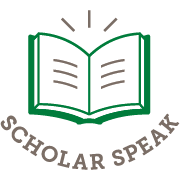This Scholar Speak post is the inspiration for the upcoming event “Speaking with Scholars on Scholarly Publishing”. Please join us Thursday (07/16) at 2pm to hear about our experiences with submitting proposals for grants, posters, columns, and exchange tips for getting through the process as a student scholar. Come to ask questions, exchange tips, and commiserate with your peers on how intimidating the whole process can be.
Register for the event at: https://unt.az1.qualtrics.com/jfe/form/SV_eFi0no9u31LOfaZ

A close up of a typewriter by Pereanu Sebastian licensed under Unsplash
The process of writing a scholarly work can be arduous. Not to discourage you, scholars, out there, but the process of publishing your work can be equally cumbersome. Thankfully, the UNT Libraries have resources and a dedicated subject librarian who can guide you through the process of getting work published! I attended one of the workshops on scholarly publishing conducted by the Scholarly Communication Librarian at UNT, John Edward Martin. From the workshop, I learned there are quite a few things that you should consider when planning to publish your scholarly work. There are various forms of scholarly work, but this post will focus on journal articles.
According to the handout provided by Martin (2019), one of the first things to consider when publishing a scholarly article is selecting a journal. You need to know or find out as much as you can about the journals and publishers with whom you want to share your work. This is important because journals tend to be discipline-specific and selecting the appropriate journal ensures that your work reaches your target audience, since different journals and publishers have different target audiences, for instance, students, researchers, internal staff, etc. To help you find the most appropriate publishing opportunities, you can use online periodical directories, like UlrichsWeb, Cabell’s Scholarly Analytics, and the Directory of Open Access Journals (DOAJ). Additionally, information such as editorial policies, especially peer review type, turnaround time, and the terms of their copyright/publication agreement should also be considered when selecting a journal as these factors govern the length of the publishing process and, more importantly, the author’s rights. UNT Libraries’ Copyright Advisory Services can help you review a publisher’s agreement and request specific rights you want to retain. You can also contact editors with specific questions regarding requirements and policies if they are not clear to you from the outset. There are also resources such as Think Check Submit checklist or COPE guidelines that you can consult if you have doubts about the quality or practices of a particular journal.
Once you’ve identified the journal, the second step is the submission. Different journals have their respective submission process, but most of the submissions are done through online submission forms. Journals have author guidelines and submission guidelines that outline the requirements for a submission to be accepted. These guidelines can include instructions on use of required citation style, preference for footnotes or endnotes, section headings, use of keywords, writing an abstract, image formats, fonts, and so forth. Submissions are often anonymized, so it is suggested not to put your name on anything but the cover sheet/submission form unless requested. Additionally, the author is also responsible for securing written permissions for any materials not covered under ‘fair use’.
After the requirements have been met and the work is submitted, it is reviewed by an editor or a team of editors, which is usually not anonymous. The editor(s) accept or reject the submission for peer review. The peer-review process takes longer than an editorial review, somewhere around 2-6 months. The peer-review process is usually “double-blind”, which means that both the reviewer and the author are kept anonymous from each other. But it can also be “single-blind”, in which the reviewers are kept anonymous to the author, “open”, in which author and reviewers both know each other’s names, and may correspond during the review process or, “community”, in which the comments or reports of the review are shared on a community forum consisting of members of that scholarly community. Very rarely is the submission accepted as is. The most common case is the author being asked to revise and resubmit the work based on the reviewers’ reports. Sometimes the editors may suggest submitting the work elsewhere, to a better-suited journal. After assessing the work to address the reviewers’ comments and meeting the revision deadline, the work is considered accepted. During this process of revision and acceptance, the author should also consider the publication agreement/contract with the journal. UNT’s Copyright Advisory Services can offer some insight pertaining to this as mentioned earlier. Then, the editor provides a copyedited and typeset draft for final proofreading to the author to double-check before publication.
Because of the digital nature of much scholarly publishing, ‘authors are increasingly involved in promoting, disseminating, and archiving their work’ (Martin, 2019). For this purpose, the UNT Digital Libraries provides digital repository services. Authors can submit their work to UNT Scholarly Works to be hosted in the UNT Digital Library. Additionally, UNT Libraries also provide a central archive, UNT Data Repository, for any research datasets that the authors use in their work, which can be linked to the articles in Scholarly Works. Both repositories provide unique identifiers and persistent URLs that make the work easy to cite and share on other platforms.
Do you have an article ready to publish? Check library resources like Scholarly Writing Guide and Scholarly Impact Guide. Reach out to UNT Libraries Scholarly Publishing Services to help with your publication needs. If you have any questions about the UNT Libraries Scholarly Publishing Services, feel free to Ask Us or contact John Martin, our Scholarly Communication Librarian directly.
Leave a comment below to let us know what you think.
Reference
Martin, J. (2019). The scholarly publication process [Workshop handout]. UNT Libraries Scholarly Communication Office, University of North Texas, Denton, TX



Leave a Reply